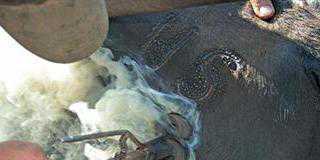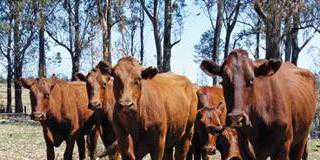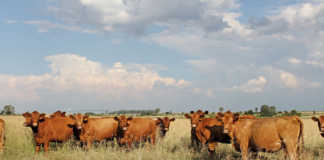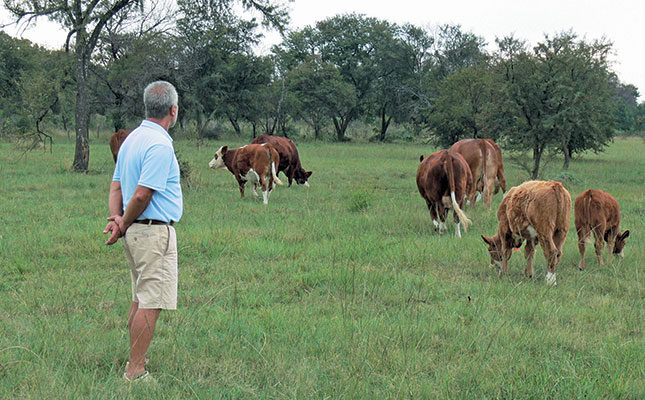
Photo: Chris Nel
A livestock farmer need not be a millionaire to be successful. In fact, starting small but with the correct attitude, aptitude, resourcefulness and hard work, he/she can achieve a great deal. Hans Franck is such a farmer.
READ 50 years of Simmentaler: From Europe to Africa
Despite the urban sprawl slowly invading from Pretoria in the west, his Macarara Simmentaler Stud succeeded in breeding the bull Gamsa LH 12 80, which represented his breed at the national special performance test class for Phase C-tested bulls at the Agricultural Research Council’s (ARC) National Beef Performers Awards in 2014.
Early inspiration
Franck’s family lived in Mozambique in the 1970s when he was a child. As little German was spoken or taught at schools in that country, he was sent as a boarder to the Deutsche Schule (German School), east of Pretoria.
During this period, a weekend visit to the Olschweski family, a well-known Simmentaler breeder, on the farm Meerhof, sparked Franck’s burning, lifelong interest in farming and a passion for Simmentaler cattle. When he said goodbye to his hosts before returning to school, he promised Gert Olschweski he would one day also farm Simmentalers.
As the eldest of six children and a fugitive in South Africa from the war in Mozambique, he had to care for his mother and his 66-year old father, who could not find work in this country.
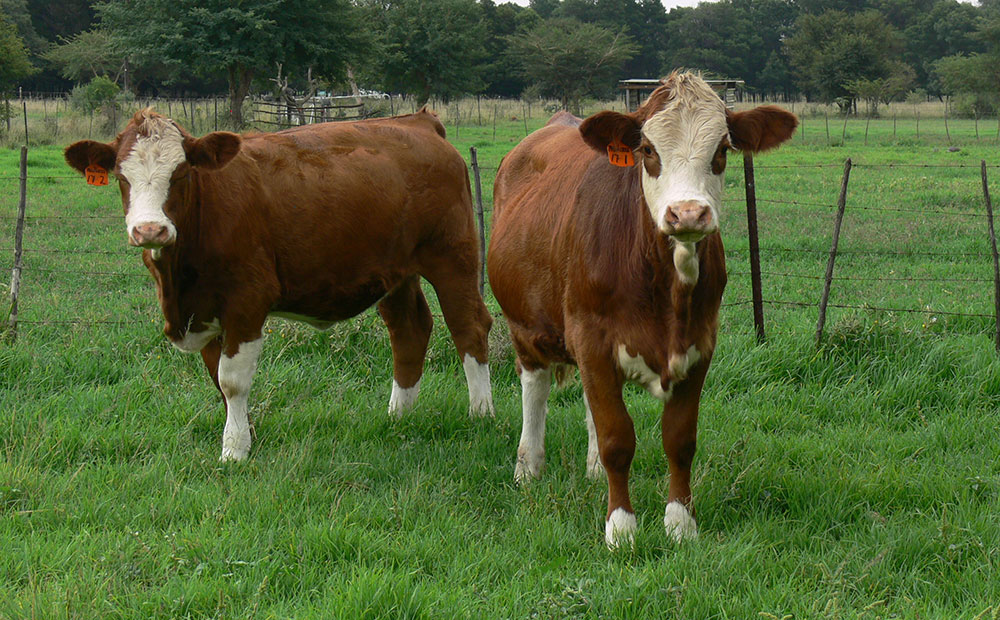
With little cash to spare, he worked at the Rembrandt factory while establishing the Macarara Simmentaler Stud, initially as a sideline, in 1984 when he was only 21 years old.
“The Simmentaler was very good for me,” he recalls.
“When I started showing in 2004, things went from good to better. I managed to breed two polled Simmentaler cows [LH 08 92 and LH 09 35] with plenty of milk and strong pigmentation. This gave me the one advantage I would ever have over the big breeders with strong financial reserves.
Many of them, even Olschweski, assured me that breeding such a cow was not possible. But ‘impossible’ was not part of my vocabulary. With mercy from above and the perseverance He gave me, it was a privilege when Peter Massman and the Simmentaler Society selected one of my polled bulls, Macarara Ganza LH 05 14 A5, as an artificial insemination bull.”
This bull and Franck’s herd gained an important advantage: by 2009, the bull had sired more calves born alive (388, of which 44 were in Franck’s herd) in five years than any other Simmentaler in the country.
Award-winning cows and bulls
In 2011, one of Franck’s cows, Macarara Silgi LH 08 92, was the Junior Champion Simmentaler Cow at the Pretoria Show.
The next year, one of his bulls, Macarara Manga LH 08 91, was Senior Champion and BLUP Champion Simmentaler Bull, and he accumulated the second highest number of points for the breed.
READ A rare crossbreeding project
In 2013, the Macarara Simmentaler Stud won most points at this show and, to top it all, the bull Macarara Gamsa LH 12 80 received a Gold Merit award from the ARC in Pretoria.
Franck’s stud, averaging around 80 cows with two or more calvings, also won the prize for the herd with the most points in 2013 and 2014.
In 2014, also at the Pretoria Show, Macarara Nepgi LH 09 35 won the Senior, Grand Champion and Reserve Super Cow classes, while Macarara Sigli LH 08 92 was the Super Cow.
Selection
Appropriate selection goals and procedures, rigorously applied over decades, have put the Macarara Simmentaler Stud in a position of excellence quite out of proportion to its modest size.
Franck said: “I select heifers on early maturity, as well as on the performance of their dams, to calve before they are 30 months old.
This is non-negotiable. A first-calf cow must be in calf again within 90 days of calving.
To be selected by Franck, a cow must produce lots of milk, with an estimated breeding value [EBV] for milk above the breed average [+5]. Similarly, her EBV for growth must also be above the breed average [+5].
“The Macarara Simmentaler herd is a polled herd; I have been selecting for it for many generations. This is an economically important factor. An animal with the polled gene puts the protein that otherwise would have been used for growing horns to more economically productive use to produce meat and/or milk,” says Franck.
According to him, in a polled herd, calves never need to be dehorned, which is a stressful procedure for the workers as well as the calves.
In addition to taking valuable time that could be better used for other tasks, dehorning holds the potential for injury and infection, as well as a temporary drop in production. “After years of strict selection, around 95% of calves born in my herd are polled.”
In crossbreeding with other cattle breeds in a commercial beef operation, the polled factor is economically significant.
“For example, polled cattle don’t easily injure themselves or other animals in close confinement when they are being driven, in a crush, being loaded or during transport.”
In addition, the stockmen and handlers working with polled animals are less prone to injury while infrastructure such as kraals, crushes and loading ramps are less prone to damage.
These economically important advantages have contributed to the Macarara stud’s polled genetics becoming increasingly valuable and sought after.
“As some other Simmentaler stud herds genetically unrelated to mine also have polled animals, the Macarara gene pool has the potential to be further supplemented and expanded. So it is by no means a genetically closed herd,” says Franck.
READ Three-way crossbreeding for optimal production
“In addition, the Simmentaler gene pool in Southern Africa and beyond has many unrelated animals heterozygous for the polled gene, and this further expands the potential genetic base of polled cattle.”
Dark pigmentation in the red sections of the skin, especially around the eyes as well as the hooves, nose and muzzle, are valuable selection criteria for Franck.
Strongly pigmented hooves are harder wearing and less inclined to crack than paler hooves.
The origin of this strong pigmentation, which also increases the skin’s resistance to UV radiation and sunburn, can be traced back to the famous German Simmentaler bull, Roman.
Marketing
“My bulls sell very well and I have never found it necessary to advertise,” Franck says.
His main clients, interestingly enough, include Nguni and Bonsmara breeders.
“One of my best bull clients, a commercial Nguni weaner producer, reported selling Simmentaler-sired first-cross weaner calves for R1 000 more, and second-cross weaner calves for R1 200 more, than pure Nguni weaners.
“I can only assume that the polled factor and strong milk production of my Simmentalers have a lot to do with it.”
Email Hans Franck at [email protected].









